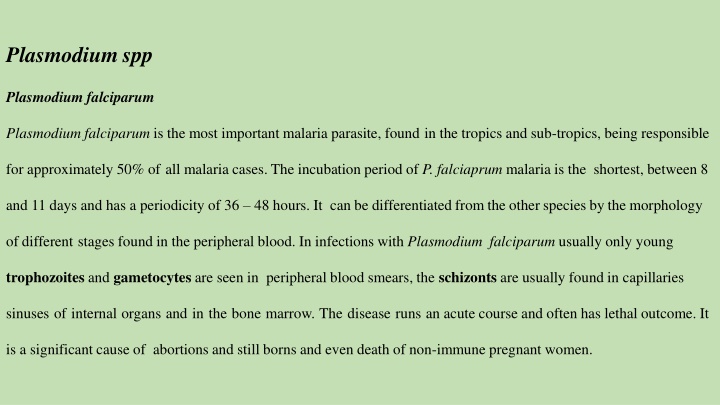Overview of Plasmodium falciparum and Plasmodium vivax Malaria Parasites
Plasmodium falciparum is the most significant malaria parasite, responsible for about 50% of cases, with a short incubation period and distinct morphology in blood smears. It causes severe symptoms and complications, affecting various organs. In contrast, Plasmodium vivax is the most common malaria parasite globally, with a wider geographic distribution. It has a longer incubation period and can lead to acute illness. Understanding the differences between these two parasites is crucial for effective malaria management.
Download Presentation

Please find below an Image/Link to download the presentation.
The content on the website is provided AS IS for your information and personal use only. It may not be sold, licensed, or shared on other websites without obtaining consent from the author.If you encounter any issues during the download, it is possible that the publisher has removed the file from their server.
You are allowed to download the files provided on this website for personal or commercial use, subject to the condition that they are used lawfully. All files are the property of their respective owners.
The content on the website is provided AS IS for your information and personal use only. It may not be sold, licensed, or shared on other websites without obtaining consent from the author.
E N D
Presentation Transcript
Plasmodium spp Plasmodium falciparum Plasmodium falciparum is the most important malaria parasite, found in the tropics and sub-tropics, being responsible for approximately 50% of all malaria cases. The incubation period of P. falciaprum malaria is the shortest, between 8 and 11 days and has a periodicity of 36 48 hours. It can be differentiated fromthe other species by the morphology of different stages found in the peripheral blood. In infections with Plasmodium falciparum usually only young trophozoites and gametocytes are seen in peripheral blood smears, the schizonts are usually found in capillaries sinuses of internal organs and in the bone marrow. The disease runs an acute course and often has lethal outcome. It is a significant cause of abortions and still borns and even death of non-immune pregnant women.
Life cycle The aspects of the life cycle, which are specific to P. falciparum, are as follows: It attacks all ages of erythrocytes so that a high density of parasites can be reached quickly. In extreme cases up to 48% of the red blood cells can be parasitised. Multiple infections resulting in several ring forms in a corpuscle are not uncommon. The latter stages in the asexual cycle do not occur in the peripheral blood as in other forms of malaria, so that only rings and crescents are found in blood films. After 24 hours the ring forms and older trophozoites show a tendency to clump together and adhere to the visceral capillary walls. They become caught up in the vessels of the heart, intestine, brain or bone marrow in which the later sexual stages are completed.
Clinical manifestations and pathogenicity of Plasmodium falciparum : 1-Symptoms include headache, photophobia, muscle aches and pains, anorexia, nausea and vomiting. Complications include severe anaemia cerebral malaria, renal disease, black water fever, dysentery, pulmonary oedema and tropical splenomegaly syndrome. 2-infection are induced by the asexual stages of the parasite that develop inside red blood cells (RBCs). Because splenic microcirculatory beds filter out altered RBCs, the spleen can innately clear subpopulations of infected or uninfected RBC modified during falciparum malaria. 3-The spleen appears more protective against severe manifestations of malaria in na ve than in immune subjects. The spleen-specific pitting function accounts for a large fraction of parasite clearance in artemisinin-treated patients. 4-RBC loss contributes to malarial anemia, a clinical form associated with subacute progression, frequent splenomegaly, and relatively low parasitemia. Stringent splenic clearance of ring-infected RBCs and uninfected, but parasite-altered, RBCs, may altogether exacerbate anemia and reduce the risks of severe complications associated with high parasite loads, such as cerebral malaria
Plasmodium vivax Plasmodium vivax is found almost in all places, where malaria is endemic and is the most predominant of malaria parasites. Causing 43% of all cases of malaria in the world, it also has the widest geographical distribution. Although the disease itself is not usually life threatening, it can cause severe acute illness. Plasmodium vivax does not infect West Africans due to the fact that West Africans do not possess the Duffy Antigen on the red blood cells, which the parasite requires to enter the red blood cell. It has an incubation period of between 10 and 17 days, which is sometimes prolonged to months or years due to the formation of hypnozoites. It has a periodicity of 48 hours. Plasmodium vivax infections are usually characterised by the presence of more than one developmental stage in the peripheral blood film. The parasites parasitise young enlarged erythrocytes and Sch ffner s dots develop on the erythrocyte membrane
Life cycle The aspects of the life cycle, which are specific to P. vivax, are as follows: The degree of infectivity is low, only the young immature corpuscles are infected; about 2% of erythrocytes are parasitised. b)The periodicity of the asexual cycle is closely synchronised. c)Hypnozoites develop in the liver, so that relapses may occur. Spread exclusively by female anopheline mosquitoes Fever paroxysm occurs over 6 - 10 hours and is initiated by the synchronous rupture of erythrocytes with the release of new infectious blood stage forms known as merozoites Transfusion induced malaria may occur when blood donors have subclinical malaria and may prove fatal for the recipient Similarly, congenital malaria may occur in infants born to mothers from endemic areas; the infant acquires the infection at birth due to rupture of placental blood vessels with maternal fetal transfusion Neither transfusion nor congenital malaria is expected to relapse because exoerythrocytic schizogony does not occur Persons who lack certain Duffy blood group determinants are protected against P. vivax infection
Clinical Signs of Disease Symptoms include headache, photophobia, muscle aches and pains, anorexia,nauseaand vomiting. Complications due to P. vivaxare relatively rare and arise due do a previous debility or pre-existing disease. Plasmodium ovale Plasmodium ovale is widely distributed in tropical Africa especially the west coast, despite that it is a species that is rarely encountered. It has also been reported in South America and Asia. It has an incubation period of 10 17 days, which is sometimes prolonged to months or years due to the formation of hypnozoites. It has a periodicity of 48 hours; the fever it produces is milder than the benign tertian P. falciparum.
Clinical Signs of Disease Symptoms, like those of P. vivax, include headache, photophobia, muscle aches and pains, anorexia, nausea and vomiting. Complications due to P. ovale are relatively rare and arise due do a previous debility or preexisting disease. Diagnosis Thick Blood Films In examining stained thick blood films, the red blood cells are lysed, so diagnosis is based on the appearance of the parasite. In thick films, organisms tend to be more compact and denser than in thin films. Thin Blood Films When examining thin blood films for malaria you must look at the infected red blood cells and the parasites inside the cells Serological diagnosis Various test kits are available to detect antigens derived from malaria parasites. Such immunologic ( immunochromatographic ) tests most often use a dipstick or cassette format, and provide results in 2 15 minutes.























